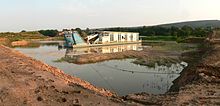Quarry pond
A Stretch (also Baggerloch , gravel pit , in Austria gravel pit ) is a man-made lake , which is usually on the degradation of gravel or sand back as a building material ( gravel surface mining ) or to another day construction mining ( open pit ). Dredging ponds from former clay pits and loam pits are also called brick ponds .
Emergence
As far as the mining cut into the groundwater horizon, groundwater-fed quarry ponds are created. Quarry ponds are seldom specifically created, especially as a local recreation area . The excavation holes are mostly landscaped in accordance with the legally required renaturation .
use
Almost always, the lake is the recreational fisheries used because by law one with each surface waters fishing rights arises. Bathing beaches are created on some lakes or set up for other types of water sports , in particular boating, water skiing or windsurfing. Large parking lots, lifeguards and restaurants will also be set up for these uses. In some cases, the quarry pond is used for nature conservation, such as the two quarry ponds in the Aitrach gravel pit nature reserve .
water
Limnologically, quarry ponds differ from natural lakes in that they generally have neither superficial inflows nor outflows. Rather, their water body corresponds to the groundwater . At the beginning there is a particularly strong groundwater flow. But within a few years the embankments of the lake basin are largely sealed by biogenic deposits. From then on the water body leads a limnological life of its own. The exchange with the surrounding groundwater is then limited to compensating for level fluctuations.
Because of this special feature, quarry ponds act as nutrient traps. More or less rapid eutrophication is therefore part of the natural life cycle of a quarry pond. Renovation is only possible in exceptional cases, if the special location in sloping terrain means that a drain can be constructed. Eutrophication leads to ever denser algae growth (including algal blooms ) and increased biomass in the subsequent stages of the food chain . As a result, the consumption of oxygen in the deeper layer ( hypolimnion ) increases more and more (see ecosystem lake ). It comes to reducing conditions under which the total phosphorus in the productive circulation remains. One then speaks of the lake tipping over . In this state, almost no forms of use are possible.
Residual lakes of lignite opencast mining ( post- mining landscape ) often show extreme water chemistry with an unusually high content of sulfuric acid , which is formed from the sulfur content of the coal residues through bacterial activities. The pH value can drop to 3. Often, larger concentrations of aluminum , manganese and iron are also released from the bedrock . If the renovation is not done sufficiently, such lakes are neither suitable for fish nor for swimming for several years. In this case , they are colonized by biocenoses of specialized organisms. To counteract these conditions, lime and caustic soda are often added for several years while the remaining open pit is being filled. Inflow and outflow conductors ensure dilution and oxygen exchange. A good example is the Senftenberger See in the Lusatian Lakeland in Brandenburg, with its very good water quality and abundance of fish.
Examples
An example of an area with eight quarry ponds is the Binsfeld near Speyer.




